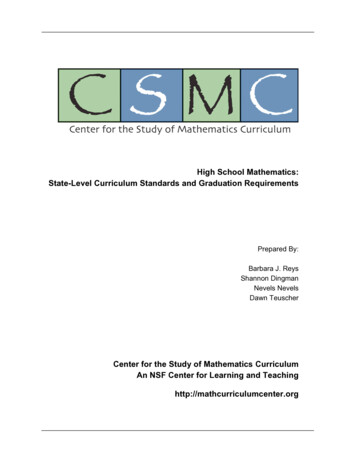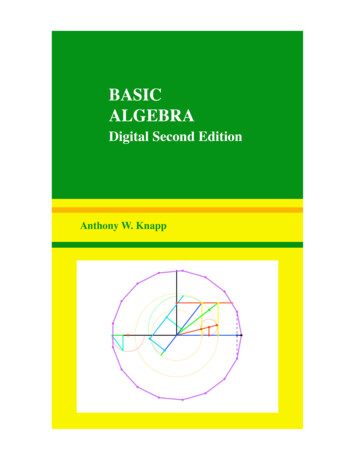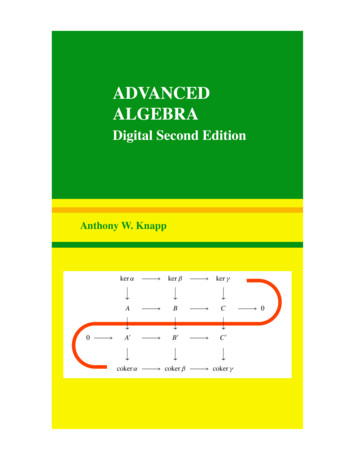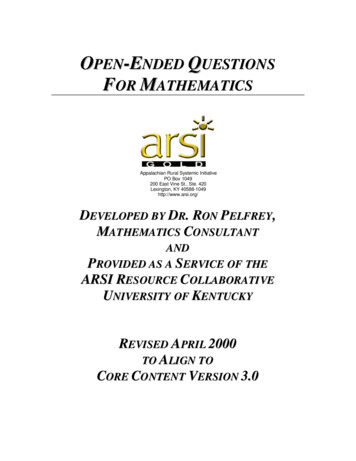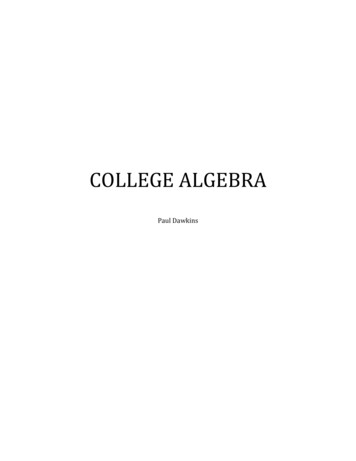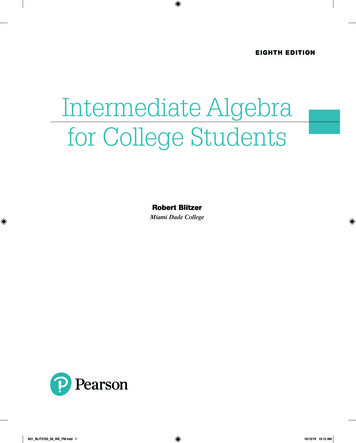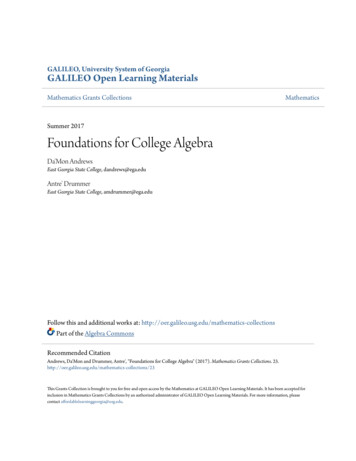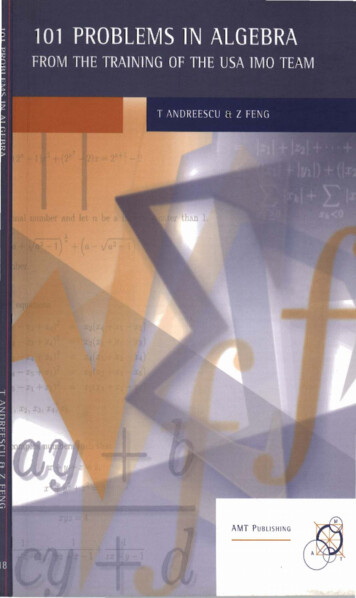
Transcription
101 PROBLEMS IN ALGEBRAFROM THE TRAINING OF THE USA IMO TEAMT ANDREESCU t Z FENDAMT PUBLISHING
101 PROBLEMS IN ALGEBRAFROM THE TRAINING OF THE USA 1MO TEAMT ANDRUSCU Ft Z FFNG
Published byAMT PUBLISHINGAustralian Mathematics TrustUniversity of Canberra ACT 2601AUSTRALIACopyright 2001 AMT PublishingTelephone: 61 2 6201 5137AMTT Limited ACN 083 950 341National Library of Australia Card Number and ISSNAustralian Mathematics Trust Enrichment Series ISSN 1326-0170101 Problems in Algebra ISBN 1 876420 12 X
THE AUSTRALIAN MATHEMATICS TRUSTENRICHMENT S E R I E SEDITORIAL COMMITTEEChairmanEditorGRAHAM H POLLARD, Canberra AUSTRALIAPETER J TAYLOR, Canberra AUSTRALIAWARREN J ATKINS, Canberra AUSTRALIAED J BARBEAU, Toronto CANADAGEORGE BERZSENYI, Terra Haute USARON DUNKLEY, Waterloo CANADAWALTER E MIENTKA, Lincoln USANIKOLAY KONSTANT1NOV, Moscow RUSSIAANDY Liu, Edmonton CANADAJORDAN B TABOV, Sofia BULGARIAJOHN WEBB, Cape Town SOUTH AFRICAThe books in this series are selected for their motivating, interestingand stimulating sets of quality problems, with a lucid expository stylein their solutions. Typically, the problems have occurred in eithernational or international contests at the secondary school level.They are intended to be sufficiently detailed at an elementary levelfor the mathematically inclined or interested to understand but, atthe same time, be interesting and sometimes challenging to theundergraduate and the more advanced mathematician. It is believedthat these mathematics competition problems are a positiveinfluence on the learning and enrichment of mathematics.
THE AUSTRALIAN MATHEMATICS TRUSTENRICHMENTSERIESBooKs IN THE SERIES1AUSTRALIAN MATHEMATICS COMPETITION BOOK 1 1978-1984JD Edwards, DJ King Et PJ O'Halloran2MATHEMATICAL TOOLCHESTAW Plank Et NH Williams3TOURNAMENT OF TOWNS QUESTIONS AND SOLUTIONS 1984-1989PJ Taylor4AUSTRALIAN MATHEMATICS COMPETITION BOOK 2 1985-1991PJ O'Halloran, G Pollard Et PJ Taylor5PROBLEM SOLVING VIA THE AMCW Atkins6TOURNAMENT OF TOWNS QUESTIONS AND SOLUTIONS 1980-1984PJ Taylor7TOURNAMENT OF TOWNS QUESTIONS AND SOLUTIONS 1989-1993PJ Taylor18ASIAN PACIFIC MATHEMATICS OLYMPIADS 1989-2000H Lausch Et C Bosch Giral9METHODS OF PROBLEM SOLVING BOOK 1JB Tabov Ft PJ Taylor10 CHALLENGE! 1991-1995JB Henry, J Dowsey, AR Edwards, U Mottershead,A Nakos Et G Vardaroii1 12USSR MATHEMATICAL OLYMPIADS 1989-1992AM SlinkoAUSTRALIAN MATHEMATICAL OLYMPIADS 1979-1995H Lausch Et PJ Taylor13CHINESE MATHEMATICS COMPETITIONS AND OLYMPIADS 1981-1993A Liu
114 POLISH Et AUSTRIAN MATHEMATICAL OLYMPIADS 1981- 1995ME Kuczma Et E Windischbacher115TOURNAMENT OF TOWNS QUES11ONS AND SOLUTIONS 1993-1997PJ Taylor Et AM Storozhev116AUSTRALIAN MATHEMATICS COMPETITION BOOK 3 1992-1998WJ Atkins, JE Munro Et PJ Taylor17SEEKING SOLUTIONSJC Burns18101 PROBLEMS IN ALGEBRAT Andreescu Et Z Feng
PREFACEThis book contains one hundred highly rated problems used in the training and testing of the USA International Mathematical Olympiad (IMO)team. It is not a collection of one hundred very difficult, impenetrablequestions. Instead, the book gradually builds students' algebraic skillsand techniques. This work aims to broaden students' view of mathematics and better prepare them for possible participation in various mathematical competitions. It provides in-depth enrichment in important areasof algebra by reorganizing and enhancing students' problem-solving tac-tics and strategies. The book further stimulates students' interest forfuture study of mathematics.
INTRODUCTIONIn the United States of America, the selection process leading to participation in the International Mathematical Olympiad (IMO) consistsof a series of national contests called the American Mathematics Contest 10 (AMC 10), the American Mathematics Contest 12 (AMC 12),the American Invitational Mathematics Examination(AIME), and theUnited States of America Mathematical Olympiad (USAMO). Participation in the AIME and the USAMO is by invitation only, based onperformance in the preceding exams of the sequence. The Mathematical Olympiad Summer Program (MOSP) is a four-week, intense training of 24-30 very promising students who have risen to the top of theAmerican Mathematics Competitions. The six students representing theUnited States of America in the IMO are selected on the basis of theirUSAMO scores and further IMO-type testing that takes place duringMOSP. Throughout MOSP, full days of classes and extensive problemsets give students thorough preparation in several important areas ofmathematics. These topics include combinatorial arguments and identities, generating functions, graph theory, recursive relations, telescopingsums and products, probability, number theory, polynomials, theory ofequations, complex numbers in geometry, algorithmic proofs, combinatorial and advanced geometry, functional equations and classical inequalities.Olympiad-style exams consist of several challenging essay problems. Cor-rect solutions often require deep analysis and careful argument. Olympiad questions can seem impenetrable to the novice, yet most can besolved with elementary high school mathematics techniques, cleverly applied.Here is some advice for students who attempt the problems that follow.Take your time! Very few contestants can solve all the given problems.Try to make connections between problems. A very importanttheme of this work is: all important techniques and ideas featuredin the book appear more than once!Olympiad problems don't "crack" immediately. Be patient. Trydifferent approaches. Experiment with simple cases. In some cases,working backward from the desired result is helpful.Even if you can solve a problem, do read the solutions. They maycontain some ideas that did not occur in your solutions, and they
viiiIntroductionmay discuss strategic and tactical approaches that can be used elsewhere. The formal solutions are also models of elegant presentation that you should emulate, but they often obscure the torturousprocess of investigation, false starts, inspiration and attention todetail that led to them. When you read the solutions, try to reconstruct the thinking that went into them. Ask yourself, "Whatwere the key ideas?" "How can I apply these ideas further?"Go back to the original problem later, and see if you can solve itin a different way. Many of the problems have multiple solutions,but not all are outlined here.All terms in boldface are defined in the Glossary. Use the glossaryand the reading list to further your mathematical education.Meaningful problem solving takes practice. Don't get discouragedif you have trouble at first. For additional practice, use the bookson the reading list.
ACKNOWLEDGEMENTSThanks to Tiankai Liu who helped in proof reading and preparing solutions.Many problems are either inspired by or fixed from mathematical contestsin different countries and from the following journals:High-School Mathematics, ChinaRevista Matematica Timi§oara, RomaniaKvant, RussiaWe did our best to cite all the original sources of the problems in the solution part. We express our deepest appreciation to the original proposersof the problems.
ABBREVIATIONS AND AMOMOSPPutnamSt. PetersburgAmerican High School MathematicsExaminationAmerican Invitational MathematicsExaminationAmerican Mathematics Contest 10American Mathematics Contest 12,which replaces AHSMEAmerican Regional Mathematics LeagueInternational Mathematical OlympiadUnited States of America Mathematical OlympiadMathematical Olympiad Summer ProgramThe William Lowell Putnam MathematicalCompetitionSt. Petersburg (Leningrad) MathematicalOlympiadNotations for Numerical Sets and FieldsZthe set of integersthe set of integers modulo nthe set of positive integersthe set of nonnegative integersthe set of rational numbersthe set of positive rational numbersthe set of nonnegative rational numbersthe set of n-tuples of rational numbersthe set of real numbersthe set of positive real numbersthe set of nonnegative real numbersthe set of n-tuples of real numbersthe set of complex numbers
ABBREVIATIONS AND NOTATIONS1. INTRODUCTORY PROBLEMS2. ADVANCED PROBLEMSxiii1133. SOLUTIONS TO INTRODUCTORY PROBLEMS 274. SOLUTIONS TO ADVANCED PROBLEMS65GLOSSARY131FURTHER READING137
INTRODUCTORY PROBLEMS
1. INTRODUCTORY PROBLEMSProblem 1Let a, b, and c be real and positive parameters. Solve the equationa bx b cx c ax b -ax c-bx a-cx.Problem 2Find the general term of the sequence defined by x0 3, x1 4 andaxn 1 xn 1 - nxnfor all' n E N.Problem 3Let x1, x2i . , X. be a sequence of integers such that(i) -1 x, 2, for z 1, 2. , n;(ii) x1 x2 xn19;(iii)Determine the minimum and maximum possible values ofxi x2 xn.Problem 4The function f, defined byf(x) ax bcx d'where a, b, c, and d are nonzero real numbers, has the propertiesf (19) 19,f (97) 97,for all values of x, except -Find the range of f.dcandf (f (x)) x,
1. Introductory Problems2Problem 5Prove that\ a (a-b)2(a-b)2 a b-8a8b2for all a b 0.Problem 6Several (at least two) nonzero numbers are written on a board. One mayerase any two numbers, say a and b, and then write the numbers a 2and b - a instead.2Prove that the set of numbers on the board, after any number of thepreceding operations, cannot coincide with the initial set.Problem 7The polynomial1-x x2-x3 . x16 x17may be written in the formao a1y a2y2 . a16y16 a17y17,where y x 1 and as are constants.Find a2.Problem 8Let a, b, and c be distinct nonzero real numbers such thata b b -c c -.111Prove that Iabcl 1.Problem 9Find polynomials f (x), g(x), and h(x), if they exist, such that for all x,1 -1If (x) I - I g(x) I h(x) 3x 2ifx -1if -1 x 0-2x 2 ifx 0.
1. Introductory Problems3Problem 10Find all real numbers x for which8x 27"12x 18x76Problem 11Find the least positive integer m such thatfor all positive integers n.Problem 12Let a, b, c, d, and e be positive integers such thatabcde a b c d e.Find the maximum possible value of max{a, b, c, d, e}.Problem 13Evaluate3200141! 2! 3! 2! 3! 4!1999! 2000! 2001!Problem 14Let x vfa2 a 1-'1a2 --a 1, a ER.Find all possible values of x.Problem 15Find all real numbers x for which10x 1lx 12x 13x 14x.
1. Introductory Problems4Problem 16Let f : N x N - N be a function such that f (1, 1) 2,f(m 1,n) f(m,n) m and f(m,n 1) f(m,n)-nfor all m,nEN.Find all pairs (p, q) such that f (p, q) 2001.Problem 17Let f be a function defined on [0, 1] such thatf (O) f(l) 1 and I f (a) - f (b)I I a - bI,for all ab in the interval [0, 1].Prove thatIf(a)-f(b)I 2Problem 18Find all pairs of integers (x, y) such thatx3 y3 (x y)2.Problem 19Let f (x) 24x2for real numbers x.Evaluatef(2001I) f(20012) f (20001)Problem 20Prove that for n 6 the equation1x1 1x22 . 1x2 1has integer solutions.Problem 21Find all pairs of integers (a, b) such that the polynomial ax17 bxls 1is divisible by x2 - x - 1.
1. Introductory Problems5Problem 22Given a positive integer n, let p(n) be the product of the non-zero digitsof n. (If n has only one digit, then p(n) is equal to that digit.) LetS p(1) p(2) p(999).What is the largest prime factor of S?Problem 23Let xn be a sequence of nonzero real numbers such thatxi 2xn 1xn2xn 2 - xn 1for n 3, 4, .Establish necessary and sufficient conditions on x1 and x2 for x., to bean integer for infinitely many values of n.Problem 24Solve the equationx3-3x x 2.Problem 25For any sequence of real numbers A {a1, a2, a3, }, define DA to bethe sequence {a2 - a1, a3 - a2, a4 - a3, .}. Suppose that all of the termsof the sequence A(AA) are 1, and that a19 a92 0.Find a1.Problem 26Find all real numbers x satisfying the equation2x 3x-4x 6x-9x 1.Problem 27Prove that8016 Ev1k 1 17.kProblem 28Determine the number of ordered pairs of integers (m, n) for which mn 0 andm3 n3 99mn 333.
1. Introductory Problems6Problem 29Let a, b, and c be positive real numbers such that a b c 4 andab bc ca 4.Prove that at least two of the inequalitiesla - bi 2,lb - cl 2,Ic - al 2are true.Problem 30Evaluaten1E (n - k)!(n k)!k OProblem 31Let 0 a 1. Solvefor positive numbers x.Problem 32What is the coefficient of x2 when(1 x)(1 2x)(1 4x).(1 2 nX)is expanded?Problem 33Let m and n be distinct positive integers.Find the maximum value of Ix' - xnl where x is a real number in theinterval (0, 1).Problem 34Prove that the polynomial(x - al)(x - a2).(x - an) - 1,where al, a2,, an are distinct integers, cannot be written as the product of two non-constant polynomials with integer coefficients, i.e., it isirreducible.
1. Introductory Problems7Problem 35Find all ordered pairs of real numbers (x, y) for which:(1 x)(1 x2)(1 x4) l y7and(1 y)(1 y2)(1 y4) 1 x7.Problem 36Solve the equation2(2x - 1)x2 (2x-2 - 2)x 2x 1 - 2for real numbers x.Problem 37Let a be an irrational number and let n be an integer greater than 1.Prove that(a a2-1) (a - a2-1)is an irrational number.Problem 38Solve the system of equations(x1 - x2 x3)2 x2(x4 x5 - x2)(x2 - x3 x4)2 x3(x5 x1 - x3)(x3 - x4 x5)2 x4(x1 x2 - x4)(x4 - x5 x1)2 x5(x2 x3 - x5)(x5 - x1 x2)2 xl(x3 x4 - xl)for real numbers x1, x2, x3, x4, x5.Problem 39Let x, y, and z be complex numbers such thatx y z 2,x2 y2 z2 3andxyz 4.Evaluate111xy z-l yz x-l zx y-1
1. Introductory Problems8Problem 40Mr. Fat is going to pick three non-zero real numbers and Mr. Taf is goingto arrange the three numbers as the coefficients of a quadratic equationx2 x 0.Mr. Fat wins the game if and only if the resulting equation has twodistinct rational solutions.Who has a winning strategy?Problem 41Given that the real numbers a, b, c, d, and e satisfy simultaneously therelationsa b c d e 8 and a2 b2 c2 d2 e2 16,determine the maximum and the minimum value of a.Problem 42Find the real zeros of the polynomialPa(x) (x2 1)(x - 1)2 - ax 2,where a is a given real number.Problem 43Prove that132n - 11242n737for all positive integers n.Problem 44LetP(x) aoxn alxn-1 . a,,be a nonzero polynomial with integer coefficients such that P(r)P(s) 0 for some integers r and s, with 0 r s.Prove that ak -s for some k.Problem 45Let m be a given real number.Find all complex numbers x such that(X) 2x22
1. Introductory Problems9Problem 46The sequence given by xo a, x1 b, andxn 1 - 1 (Xn-1 21I.is periodic.Prove that ab 1.Problem 47Let a, b, c, and d be real numbers such that(a2 b2-1)(c2 d2-1) (ac bd-1)2.Prove thata2 b2 1 and c2 d2 1.Problem 48Find all complex numbers z such that(3z 1)(4z 1)(6z 1)(12z 1) 2.Problem 49Let x1i x2,-, xn 1i be the zeros different from 1 of the polynomialP(x) xn-1,n 2.Prove that111-x1 1-x2 . 1n-11-xn 12Problem 50Let a and b be given real numbers. Solve the system of equationsx - yx 2-yz1-x2 y2a,y - x x2-y2 b1-x2 y2for real numbers x and y.
ADVANCED PROBLEMS
2. ADVANCED PROBLEMSProblem 51Evaluate0200 0) (2000) 25 . (2000)(20800)Problem 52Let x, y, z be positive real numbers such that x4 y4 z4 1.Determine with proof the minimum value ofx3yz331-x8 1y8 1-z8.Problem 53Find all real solutions to the equation2X 32: 6X x2.Problem 54Let {an}n 1 be a sequence such that al 2 andan i an21 anfor allneN.Find an explicit formula for an.Problem 55Let x, y, and z be positive real numbers. Prove thatxx (x y)(x z) yy (y z)(y x)z z (z - X) (z y)
2. Advanced Problems14Problem 56Find, with proof, all nonzero polynomials f (z) such thatf(z2) f(z)f(z 1) 0.Problem 57Let f : N -* N be a function such that f (n 1) f (n) andf (f (n)) 3nfor all n.Evaluate f (2001).Problem 58Let F be the set of all polynomials f (x) with integers coefficients suchthat f (x) 1 has at least one integer root.For each integer k 1, find mk, the least integer greater than 1 forwhich there exists f E F such that the equation f (x) Mk has exactlyk distinct integer roots.Problem 59Let x1 2 andx' 12 xn-x, 1,for n 1.Prove that122", 1 1 . 1 1-22,,xnx1x2Problem 60Suppose that f : R - 1[8 is a decreasing function such that for allx,yER ,f(x y) N(X) f(y)) f(f(x f(y)) f(y f(x))).Prove that f(f(x)) x.
2. Advanced Problems15Problem 61Find all functions f : Q - Q such thatf(x y) f(x - y) 2f(x) 2f(y)for all x, y E Q.Problem 62Let2 a 1.Prove that the equationx3(x 1) (x a)(2x a)has four distinct real solutions and find these solutions in explicit form.Problem 63Let a, b, and c be positive real numbers such that abc 1.Prove thata b l b c l c a l C1Problem 64Find all functions f, defined on the set of ordered pairs of positive integers, satisfying the following properties:f(x,x) x, f(x,y) f(y,x), (x y)f(x,y) yf(x,x y).Problem 65Consider n complex numbers zk, such that zk 1, k 1,2,. , n.Prove that there exist e1, e2, . , en E {-1, 1} such that, for any m n, 2.Problem 66Find a triple of rational numbers (a, b, c) such that932-1 3a 3b yc-.
2. Advanced Problems16Problem 67Find the minimum oflogxl (X2 -14 logX21xl - 41X3 4) . logywhere x1i x2, . , xn, are real numbers in the interval (4, 1).Problem 68Determine x2 y2 z2 w2 ifx2y2w2,Z222-12 22-32 22-52 22-72x22w2,Z242-12 42-32 42-52 42-72x22z2w262 - 2 62 - Y32 62 - 52 62lx2y2- 72 1,w2z282-12 82-32 82-52 82-72-1.Problem 69Find all functions f : R - R such thatf(xf(x) f(y)) (f(x))2 yfor all x, y E R.Problem 70The numbers 1000, 1001,, 2999 have been written on a board.Each time, one is allowed to erase two numbers, say, a and b, and replacethem by the number 2 min(a, b).After 1999 such operations, one obtains exactly one number c on theboard. Prove that c 1.Problem 71Let al, a2. , a,,, be real numbers, not all zero.Prove that the equation1 a1x has at most one nonzero real root.1 a,,x n
2. Advanced Problems17Problem 72Let {an} be the sequence of real numbers defined by al t andan i 4an(1 - an)forn 1.For how many distinct values of t do we have ai998 0?Problem 73(a) Do there exist functions f : JR -- JR and g : JR - R such thatandf(g(x)) x2g(f(x)) x3for all x E R?(b) Do there exist functions f : JR - JR and g : JR - JR such thatandf(g(x)) x2g(f(x)) x4for allxEJR?Problem 74Let 0 al a2 an, 0 bl b2n. bn be real numbers such thatnE ai E bi.i 1i 1Suppose that there exists 1 k n such that bi ai for 1 i k andb2a2 for i k.Prove thatala2 . an blb2 . b,.Problem 75, as, prove that at least oneof the following six numbers: alai a2a4, alas a2a6, ala7 a2a8,Given eight non-zero real numbers al, a2,a3a5 a4a6, a3a7 a4a8, a5a7 a6a8 is non-negative.Problem 76Let a, b and c be positive real numbers such that abc 1.Prove thatabbecaas b5 ab b5 c5 bc c5 a5 cal
2. Advanced Problems18Problem 77Find all functions f : R - R such that the equalityf(f(x) y) f(x2 - y) 4f(x)yholds for all pairs of real numbers (x, y).Problem 78Solve the system of equations:3x - yx x2 y2 3x 3yx2 y2 0.YProblem 79Mr. Fat and Mr. Taf play a game with a polynomial of degree at least 4:x2n x2n-1 x2n-2 . x 1.They fill in real numbers to empty spaces in turn. If the resulting polynomial has no real root, Mr. Fat wins; otherwise, Mr. Taf wins.If Mr. Fat goes first, who has a winning strategy?Problem 80Find all positive integers k for which the following statement is true: ifF(x) is a polynomial with integer coefficients satisfying the condition0 F(c) k for c 0,1,.,k 1,then F(O) F(1) . F(k 1).Problem 81The Fibonacci sequence Fn is given byF1 F2 1,Fn 2 Fn 1 Fn (nEN).Prove that3F2n F2n3 2 Fen-2 9for alln 2.2F2.
2. Advanced Problems19Problem 82Find all functions u : lib - R for which there exists a strictly monotonicfunction f :ill; - l such thatf(x y) f(x)u(y) f(y)for all x, y E R.Problem 83Let z1i Z2. , zn be complex numbers such thatIz1I Iz21 . znl 1.Prove that there exists a subset S of {z1, Z2. , zn} such thatI: zzES6Problem 84A polynomial P(x) of degree n 5 with integer coefficients and n distinctinteger roots is given.Find all integer roots of P(P(x)) given that 0 is a root of P(x).Problem 85Two real sequences x1i x2, . , and y1, Y2, . , are defined in the followingway:X1 Ill V3,xn 1 xn andYn 1 1 X,yn1 -}1 y2for all n 1. Prove that 2 xnyn 3 for all n 1.Problem 86For a polynomial P(x), define the difference of P(x) on the interval [a, b](a, b), (a, b]) as P(b) - P(a).Prove that it is possible to dissect the interval [0, 1] into a finite numberof intervals and color them red and blue alternately such that, for everyquadratic polynomial P(x), the total difference of P(x) on red intervalsis equal to that of P(x) on blue intervals.What about cubic polynomials?([a, b),
2. Advanced Problems20Problem 87Given a cubic equationx3 x2 x - 0,Mr. Fat and Mr. Taf are playing the following game. In one move, Mr.Fat chooses a real number and Mr. Taf puts it in one of the empty spaces.After three moves the game is over. Mr. Fat wins the game if the finalequation has three distinct integer roots.Who has a winning strategy?Problem 88Let n 2 be an integer and let f :]I82--- R be a function such that forany regular n-gon A1A2 . An,f(A1) f(A2) . f(An) 0.Prove that f is the zero function.Problem 89Let p be a prime number and let f (x) be a polynomial of degree d withinteger coefficients such that:(i) f (0) 0, f (1) 1;(ii) for every positive integer n, the remainder upon division of f (n)by p is either 0 or 1.Prove that d p - 1.Problem 90Let n be a given positive integer.Consider the sequence ao, a1,, an,with ao 2 and2ak ak-1 fork 1,2,ak 1n,n.Prove that1-1 an, 1.n
2. Advanced Problems21Problem 91Let a1, a2. , an be nonnegative real numbers, not all zero.(a) Prove that xn - alxn-1 -- an-lx - an 0 has precisely onepositive real root R.(b) Let A 1aj andB yn3a,.Prove that AA RB.Problem 92Prove that there exists a polynomial P(x, y) with real coefficients suchthat P(x, y) 0 for all real numbers x and y, which cannot be writtenas the sum of squares of polynomials with real coefficients.Problem 93For each positive integer n, show that there exists a positive integer ksuch thatk f(x)(x 1)2n g(x)(x2n 1)for some polynomials f, g with integer coefficients, and find the smallestsuch k as a function of n.Problem 94Let x be a positive real number.(a) Prove that(n - 1)! OE(x n)1x'(b) Prove that00n 1(n-1)!n(x 1).(x n)001ti 1(x k)2*
2. Advanced Problems22Problem 95Let n 3 be an integer, and letX C S {1,2,.,n3}be a set of 3n2 elements.Prove that one can find nine distinct numbers a,, bz, c, (i 1, 2, 3) in Xsuch that the systemaix bly c1z 0a2x b2y c2z 0a3x b3y c3z 0has a solution (x0, yo, z0) in nonzero integers.Problem 96Let n 3 be an integer and let x1, x2,, xn be positive real numbers.nSuppose that ) 1.1Prove thatx1 x2 . xn (n-1)1xl1 . x21xnProblem 97Let x1, X2. , xn be distinct real numbers. Define the polynomialsP(x) (x - x1)(x -x2).(x- xn)andQ(x) P(x)(I . -L-)1x-x1 x-x2x - xnLet y', y2, . , yn 1 be the roots of Q. Show thatinIxi - x,j inlyi-y31.
2. Advanced Problems23Problem 98Show that for any positive integer n, the polynomialAX) (x2 x)2' 1cannot be written as the product of two non-constant polynomials withinteger coefficients.Problem 99Let fl, f2i f3 : JR - JR be functions such thata1f1 a2f2 a3f3is monotonic for all al, a2, a3 E R.Prove that there exist c1, c2, c3 E JR, not all zero, such thatCI fl (x) C2f2(x) C3f3(x) 0for allxEJR.Problem 100Let X1, x2, . , xn be variables, and let yi, y2, . , Y2" 1 be the sums ofnonempty subsets of xi.Let pk(xl, . , x7) be the kth elementary symmetric polynomial inthe yi (the sum of every product of k distinct yis).For which k and n is every coefficient of pk (as a polynomial in xl. , xn)even?For example, if n 2, then yl, y2i y3 are x1, x2, x1 x2 andp1 Yi y2 y3 2x1 2x2iP2 Y1Y2 Y2Y3 y3y1 xl X2 3x1x2iP3 y1112y3 xlx2 xlx2Problem 101Prove that there exist 10 distinct real numbers al, a2i ., alo such thatthe equation(x - al)(x - a2) . (x - alo) (x al)(x a2).(x alo)has exactly 5 different real roots.
SOLUTIONS TOINTRODUCTORY PROBLEMS
3. SOLUTIONS TOINTRODUCTORY PROBLEMSProblem 1 [Romania 1974]Let a, b, and c be real and positive parameters.Solve the equationa bx vl'bc ax ax c-bx a-cx.Solution 1It is easy to see that x 0 is a solution. Since the right hand side is adecreasing function of x and the left hand side is an increasing functionof x, there is at most one solution.Thus x 0 is the only solution to the equation.Problem 2Find the general term of the sequence defined by xo 3, x1 4 and2xn 1 xn 1- nxnfor allnEN.Solution 2We shall prove by induction that xn n 3. The claim is evident forn 0,1.Fork 1,ifxk 1 k 2 k 2andXk k 3, thenXk 1 x2 1 - kxk (k 2)2 - k(k 3) k 4,as desired.This completes the induction.
3. Solutions to Introductory Problems28Problem 3 [AHSME 1999]Let x1i X2. , x, be a sequence of integers such that(i) -1 xti 2, for i 1, 2,. , n;(ii)xl x2 x2 99.Determine the minimum and maximum possible values ofxi x2 . xn.Solution 3Let a, b, and c denote the number of -Is, Is, and 2s in the sequence,respectively. We need not consider the zeros. Then a, b, c are nonnegativeintegers satisfying-a b 2c 19 and a b 4c 99.It follows that a 40 - c and b 59 - 3c, where 0 c 19 (since b 0),so xn -a b 8c 19 6c.xl x2 When c 0 (a 40, b 59), the lower bound (19) is achieved.When c 19 (a 21, b 2), the upper bound (133) is achieved.Problem 4 [AIME 1997]The function f, defined byf(x) ax bcx d'where a, b, c, and d are nonzero real numbers, has the propertiesf (97) 97,f (19) 19,andfor all values of x, except - dCFind the range of f.Solution 4, Alternative 1For all x, f (f (x)) x, i.e.,(ax b ) bcx dax bc(cx d) da-x'f (f (x)) x,
3. Solutions to Introductory Problems29(a2 bc)x b(a d)x,c(a d)x be d2 -c(a d)x2 (d2 - a2)x - b(a d) 0,which implies that c(a d) 0. Since c 0, we must have a -d.The conditions f (19) 19 and f (97) 97 lead to the equations192c 2. 19a b972c 2.97a b.andHence(972 - 192)c 2(97 - 19)a.It follows that a 58c, which in turn leads to b -1843c. ThereforeAx) 58x - 1843 58 x-581521x-58'which never has the value 58.Thus the range of f is R - {58}.Solution 4, Alternative 2The statement implies that f is its own inverse. The inverse may befound by solving the equationay bcy dfor y. This yieldsfi(x)dx-b-cx aThe nonzero numbers a, b, c, and d must therefore be proportional to d,-b, -c, and a, respectively; it follows that a -d, and the rest is thesame as in the first solution.Problem 5Prove that(a-b)28aa b-2a (a-b)28bfor all a b 0.Solution 5, Alternative 1Note that C2f/ 1 V1 2VbJ,
3. Solutions to Introductory Problems30(V 1b Vb-)2(Vw-Vb-)2 (Vu-VO)2 (/ /)2(/ -Vrb)24a4b(a-b)28a -a-2 ab b2 -(a-b)28bfrom which the result follows.Solution 5, Alternative 2Note that(a b\2a b2ab 2a b 2abab(a-b)22(a b) 4 abThus the desired inequality is equivalent to4a a b 2 ab 4b,which is evident as a b 0 (which implies a ab b).Problem 6 [St. Petersburg 1989]Several (at least two) nonzero numbers are written on a board. One mayerase any two numbers, say a and b, and then write the numbers a 2and b - 2 instead.Prove that the set of numbers on the board, after any number of thepreceding operations, cannot coincide with the initial set.Solution 6Let S be the sum of the squares of the numbers on the board. Note thatS increases in the first operation and does not decrease in any successiveoperation, asCa 2\2J (b-2)2 4(a2 b2) a2 b2with equality only if a b 0.This completes the proof.
3. Solutions to Introductory Problems31Problem 7 [AIME 1986]The polynomial1-x x2-x3 x16-x17may be written in the formao aly a2y2 . a16y16 a17y17,where y x 1 and as are constants. Find a2.Solution 7, Alternative 1Let f (x) denote the given expression. Thenxf(x) x-x2 x3-.-x18and(1 x)f(x) 1 - x18.Hencef(x) f(y - 1) 1 - (y - 1)18-1 - (y - 1)181 (y-1)yTherefore a2 is equal to the coefficient of y3 in the expansion of1-(y-1)1sa2 (18) 816.Solution 7, Alternative 2Let f (x) denote the given expression. Thenf(x) f(y - 1) 1(y - 1) (y - 1)2(y - 1) 1 (1-y) (1-y)2 . (1-y)17.Thusa2 (2 )2 (1), . (17) Here we used the formula(n)k (k 1) - (k 1and the fact that(22)(33) 1.(18).17
3. Solutions to Introductory Problems32Problem 8Let a, b, and c be distinct nonzero real numbers such thata - b - c -.Prove that IabcI 1.Solution 8From the given conditions it follows thata-b b bc c ,b -c ccaa, andc-a aabb.Multiplying the above equations gives (abc)2 1, from which the desiredresult follows.Problem 9 [Putnam 1999]Find polynomials f (x), g(x), and h(x), if they exist, such that for all x,ifx -1-1If (X) I - Ig(x) I h(x) if -1 x 0-2x 2 ifx 0.3x 2Solution 9, Alternative 1Since x -1 and x 0 are the two critical values of the absolutefunctions, one can suppose thatF(x) alx 1 l blxl cx d(c-a-b)x d-a ifx -1(a c-b)x a d if-1 x 0(a b c)x a d ifx 0,which implies that a 3/2, b -5/2, c -1, and d 1/2.Hence f (x) (3x 3)/2, g(x) 5x/2, and h(x) -x z .Solution 9, Alternative 2Note that if r(x) and s(x) are any two functions, thenmax(r, s) r s Ir- sl2Therefore, if F(x) is the given function, we haveF(x) max{-3x - 3, 0} -max{5x, 0} 3x 2 (-3x - 3 13x 31)/2 - (5x I5xl)/2 3x 2 1(3x 3)/21 - 15x/21 - x 21.
3. Solutions to Introductory Problems33Problem 10Find all real numbers x for which8x 27x712x 18x6Solution 10By setting 2x a and 3x b, the equation becomesa3 b3a2b b2a76a2 - ab
the australian mathematics trust e n r i c h m e n t s e r i e s books in the series 1 australian mathematics competition book 1 1978-1984 jd edwards, dj king et pj o'halloran 2 mathematical toolchest aw plank et nh williams 3 tournament of towns questions and solutions 1984-1989 pj taylor 4 australian
